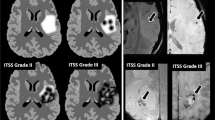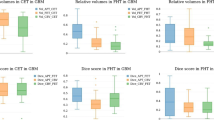Abstract
Purpose
Tumor-associated macrophages (TAMs) are a key component of glioblastoma (GBM) microenvironment. Considering the differential role of different TAM phenotypes in iron metabolism with the M1 phenotype storing intracellular iron, and M2 phenotype releasing iron in the tumor microenvironment, we investigated MRI to quantify iron as an imaging biomarker for TAMs in GBM patients.
Methods
21 adult patients with GBM underwent a 3D single echo gradient echo MRI sequence and quantitative susceptibility maps were generated. In 3 subjects, ex vivo imaging of surgical specimens was performed on a 9.4 Tesla MRI using 3D multi-echo GRE scans, and R2* (1/T2*) maps were generated. Each specimen was stained with hematoxylin and eosin, as well as CD68, CD86, CD206, and l-Ferritin.
Results
Significant positive correlation was observed between mean susceptibility for the tumor enhancing zone and the l-ferritin positivity percent (r = 0.56, p = 0.018) and the combination of tumor’s enhancing zone and necrotic core and the l-Ferritin positivity percent (r = 0.72; p = 0.001). The mean susceptibility significantly correlated with positivity percent for CD68 (ρ = 0.52, p = 0.034) and CD86 (r = 0.7 p = 0.001), but not for CD206 (ρ = 0.09; p = 0.7). There was a positive correlation between mean R2* values and CD68 positive cell counts (r = 0.6, p = 0.016). Similarly, mean R2* values significantly correlated with CD86 (r = 0.54, p = 0.03) but not with CD206 (r = 0.15, p = 0.5).
Conclusions
This study demonstrated the potential of MR quantitative susceptibility mapping as a non-invasive method for in vivo TAM quantification and phenotyping. Validation of these findings with large multicenter studies is needed.


Similar content being viewed by others
Data availability
The datasets generated during and/or analyzed during the current study are available from the corresponding author on reasonable request.
References
Thakkar JP, Dolecek TA, Horbinski C, Ostrom QT, Lightner DD, Barnholtz-Sloan JS et al (2014) Epidemiologic and molecular prognostic review of glioblastoma. Cancer Epidemiol, Biomark Prev 23:1985–199610
Pombo Antunes AR, Scheyltjens I, Duerinck J, Neyns B, Movahedi K, Van Ginderachter JA (2020) Understanding the glioblastoma immune microenvironment as basis for the development of new immunotherapeutic strategies. eLife 9:e52176
Chen Z, Hambardzumyan D (2018) Immune microenvironment in glioblastoma subtypes. Front Immunol 9:1004
Sampson JH, Gunn MD, Fecci PE, Ashley DM (2020) Brain immunology and immunotherapy in brain tumours. Nat Res 20:12–25
Morisse MC, Jouannet S, Dominguez-Villar M, Sanson M, Idbaih A (2018) Interactions between tumor-associated macrophages and tumor cells in glioblastoma: unraveling promising targeted therapies. Expert Rev Neurother 18(9):729–737
Pfeifhofer-Obermair C, Tymoszuk P, Petzer V, Weiss G, Nairz M (2018) Iron in the tumor microenvironment-connecting the dots. Front Oncol 8:549
Recalcati S, Locati M, Marini A, Santambrogio P, Zaninotto F, De Pizzol M et al (2010) Differential regulation of iron homeostasis during human macrophage polarized activation. Eur J Immunol 40(3):824–835
Sica A, Erreni M, Allavena P, Porta C (2015) Macrophage polarization in pathology. Birkhauser Verlag AG, Basel, pp 4111–4126
Leblond MM, Pérès EA, Helaine C, Gérault AN, Moulin D, Anfray C et al (2017) M2 macrophages are more resistant than M1 macrophages following radiation therapy in the context of glioblastoma. Oncotarget 8(42):72597–72612
Pollard JW (2004) Tumour-educated macrophages promote tumour progression and metastasis. European Association for Cardio-Thoracic Surgery, Windsor, pp 71–78
Wang Q, He Z, Huang M, Liu T, Wang Y, Xu H et al (2018) Vascular niche IL-6 induces alternative macrophage activation in glioblastoma through HIF-2α. Nat Commun 9(1):559
Zhou K, Cheng T, Zhan J, Peng X, Zhang Y, Wen J et al (2020) Targeting tumor-associated macrophages in the tumor microenvironment. Oncol Lett 20(5):234
Aquino D, Gioppo A, Finocchiaro G, Bruzzone MG, Cuccarini V (2017) MRI in glioma immunotherapy: evidence, pitfalls, and perspectives. J Immunol Res 2017:5813951
Klemm F, Maas RR, Bowman RL, Kornete M, Soukup K, Nassiri S et al (2020) Interrogation of the microenvironmental landscape in brain tumors reveals disease-specific alterations of immune cells. Cell 181(7):1643-60e17
Tan AC, Ashley DM, López GY, Malinzak M, Friedman HS, Khasraw M (2020) Management of glioblastoma: State of the art and future directions. Cancer J Clin 70(4):299–312
Haacke EM, Cheng NYC, House MJ, Liu Q, Neelavalli J, Ogg RJ et al (2005) Imaging iron stores in the brain using magnetic resonance imaging. Magn Reson Imaging 23(1):1–25
Liu C, Li W, Tong KA, Yeom KW, Kuzminski S (2015) Susceptibility-weighted imaging and quantitative susceptibility mapping in the brain. Wiley, New York, pp 23–41
Duyn J (2013) MR susceptibility imaging. J Magn Reson 229:198–207
Leftin A, Ben-Chetrit N, Klemm F, Joyce JA, Koutcher JA (2017) Iron imaging reveals tumor and metastasis macrophage hemosiderin deposits in breast cancer. PLoS ONE 12(9):e0184765
Leftin A, Zhao H, Turkekul M, de Stanchina E, Manova K, Koutcher JA (2017) Iron deposition is associated with differential macrophage infiltration and therapeutic response to iron chelation in prostate cancer. Sci Rep 7(1):11632
Schenck JF (1996) The role of magnetic susceptibility in magnetic resonance imaging: MRI magnetic compatibility of the first and second kinds. Med Phys 23(6):815–850
Louis DN, Perry A, Reifenberger G, von Deimling A, Figarella-Branger D, Cavenee WK et al (2016) The 2016 world health organization classification of tumors of the central nervous system: a summary. Acta Neuropathol 131(6):803–820
Bankhead P, Loughrey MB, Fernández JA, Dombrowski Y, McArt DG, Dunne PD et al (2017) QuPath: ppen source software for digital pathology image analysis. Sci Rep 7(1):1–7
Yushkevich PA, Piven J, Hazlett HC, Smith RG, Ho S, Gee JC et al (2006) User-guided 3D active contour segmentation of anatomical structures: significantly improved efficiency and reliability. NeuroImage 31(3):1116–1128
Liu T, Liu J, De Rochefort L, Spincemaille P, Khalidov I, Ledoux JR et al (2011) Morphology enabled dipole inversion (MEDI) from a single-angle acquisition: comparison with COSMOS in human brain imaging. Magn Reson Med 66(3):777–783
Smith SM (2002) Fast robust automated brain extraction. Hum Brain Mapp 17(3):143–155
Bilgic B, Fan AP, Polimeni JR, Cauley SF, Bianciardi M, Adalsteinsson E et al (2014) Fast quantitative susceptibility mapping with L1-regularization and automatic parameter selection. Magn Reson Med 72(5):1444–1459
Langkammer C, Schweser F, Shmueli K, Kames C, Li X, Guo L et al (2018) Quantitative susceptibility mapping: Report from the 2016 reconstruction challenge. Magn Reson Med 79(3):1661–1673
Sun H, Wilman AH (2014) Background field removal using spherical mean value filtering and Tikhonov regularization. Magn Reson Med 71(3):1151–1157
Chavhan GB, Babyn PS, Thomas B, Shroff MM, Mark Haacke E (2009) Principles, techniques, and applications of T2*-based MR imaging and its special applications. Radiographics 29(5):1433–1449
Beard JL, Connor JR, Jones BC (1993) Iron in the brain. Oxford Academic, Oxford, pp 157–170
Connor JR, Menzies SL (1995) Cellular management of iron in the brain. J Neurol Sci 134(SUPPL):33–44
Matsuda KM, Lopes-Calcas A, Honke ML, O’Brien-Moran Z, Buist R, West M et al (2017) Ex vivo tissue imaging for radiology-pathology correlation: a pilot study with a small bore 7-T MRI in a rare pigmented ganglioglioma exhibiting complex MR signal characteristics associated with melanin and hemosiderin. J Med Imaging (Bellingham, Wash) 4(3):036001
Leftin A, Ben-Chetrit N, Joyce JA, Koutcher JA (2019) Imaging endogenous macrophage iron deposits reveals a metabolic biomarker of polarized tumor macrophage infiltration and response to CSF1R breast cancer immunotherapy. Sci Rep 9(1):857
Iv M, Samghabadi P, Holdsworth S, Gentles A, Rezaii P, Harsh G et al (2019) Quantification of macrophages in high-grade gliomas by using ferumoxytol-enhanced MRI: a pilot study. Radiology 290(1):198–206
Zhou J, Reddy MV, Wilson BKJ, Blair DA, Taha A, Frampton CM et al (2018) MR imaging characteristics associate with tumor-associated macrophages in glioblastoma and provide an improved signature for survival prognostication. Am J Neuroradiol 39(2):252–259
Zhang M, Hutter G, Kahn SA, Azad TD, Gholamin S, Xu CY et al (2016) Anti-CD47 treatment stimulates phagocytosis of glioblastoma by M1 and M2 polarized macrophages and promotes M1 polarized macrophages in vivo. PLoS ONE 11(4):e0153550
Li F, Lv B, Liu Y, Hua T, Han J, Sun C et al (2018) Blocking the CD47-SIRPα axis by delivery of anti-CD47 antibody induces antitumor effects in glioma and glioma stem cells. OncoImmunology 7(2):e1391973
Hoves S, Ooi CH, Wolter C, Sade H, Bissinger S, Schmittnaegel M et al (2018) Rapid activation of tumor-associated macrophages boosts preexisting tumor immunity. J Exp Med 215(3):859–876
Urban-Wojciuk Z, Khan MM, Oyler BL, Fåhraeus R, Marek-Trzonkowska N, Nita-Lazar A et al (2019) The role of TLRs in anti-cancer Immunity and tumor rejection. Front Immunol 10:2388
Alvarado AG, Thiagarajan PS, Mulkearns-Hubert EE, Silver DJ, Hale JS, Alban TJ et al (2017) Glioblastoma cancer stem cells evade innate immune suppression of self-renewal through reduced TLR4 expression. Cell Stem Cell 20(4):450-61e4
Akkari L, Bowman RL, Tessier J, Klemm F, Handgraaf SM, de Groot M et al (2020) Dynamic changes in glioma macrophage populations after radiotherapy reveal CSF-1R inhibition as a strategy to overcome resistance. Sci Transl Med. https://doi.org/10.1126/scitranslmed.aaw7843
Pires-Afonso Y, Niclou SP, Michelucci A (2020) Revealing and harnessing tumour-associated microglia/macrophage heterogeneity in glioblastoma. Int J Mol Sci 21(3):689
Shenoy G, Madhankumar A, Slagle-Webb B, Mrowczynski O, Schell T, Nesterova D et al (2019) TMIC-31. Impact of iron on macrophage immune phenotype in the glioblastoma tumor microenvironment. Neurooncology 21(Supplement_6):vi254-vi
Mukherjee S, Sonanini D, Maurer A, Daldrup-Link HE (2019) The yin and yang of imaging tumor associated macrophages with PET and MRI. Theranostics 9(25):7730–7748
Ammer LM, Vollmann-Zwerenz A, Ruf V, Wetzel CH, Riemenschneider MJ, Albert NL et al (2020) The role of translocator protein TSPO in hallmarks of glioblastoma. Cancers 12(10):2973
Adler DH, Wisse LEM, Ittyerah R, Pluta JB, Ding SL, Xie L et al (2018) Characterizing the human hippocampus in aging and Alzheimer’s disease using a computational atlas derived from ex vivo MRI and histology. Proc Natl Acad Sci USA 115(16):4252–4257
Patel AP, Tirosh I, Trombetta JJ, Shalek AK, Gillespie SM, Wakimoto H et al (2014) Single-cell RNA-seq highlights intratumoral heterogeneity in primary glioblastoma. Science (New York, NY) 344(6190):1396–1401
Funding
McCabe Fund Award granted to S.A.N from the Perelman School of Medicine, University of Pennsylvania.
Author information
Authors and Affiliations
Contributions
Conceptualization: MN, AN, AN, SCG, YF, JBW, WRW, RR, SJB, AD, DMO, SB. Acquisition of data: AN, SCG, MP, JBW. Preprocessing of images: AN, SCG. Writing—original draft preparation: AN, SCG, AN. Writing—review and editing: AN, SCG, MP, JBW, HA, SKI, BFM, YF, WRW, RR, SJB, AD, DMO, SB, MN, AN.
Corresponding author
Ethics declarations
Conflict of interest
The authors declare no potential conflicts of interest.
Ethical approval
All procedures performed in studies involving human participants were in accordance with the ethical standards of the institutional research committee and with the 1964 Helsinki declaration and its later amendments.
Informed consent
Informed consent was obtained from all individual participants included in the study.
Additional information
Publisher’s Note
Springer Nature remains neutral with regard to jurisdictional claims in published maps and institutional affiliations.
Supplementary Information
Below is the link to the electronic supplementary material.
Rights and permissions
About this article
Cite this article
Nazem, A., Guiry, S.C., Pourfathi, M. et al. MR susceptibility imaging for detection of tumor-associated macrophages in glioblastoma. J Neurooncol 156, 645–653 (2022). https://doi.org/10.1007/s11060-022-03947-3
Received:
Accepted:
Published:
Issue Date:
DOI: https://doi.org/10.1007/s11060-022-03947-3




